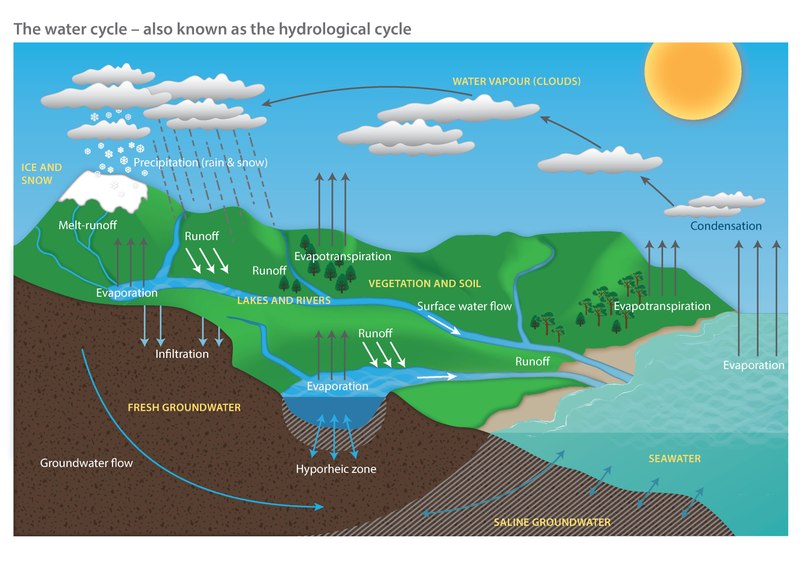Sumi Vora
AP Environmental Science ♻️
252 resourcesSee Units
The Water Cycle 🌧
The water cycle, also known as the hydrologic cycle, is the most basic of the biogeochemical cycles. It is important to note that water can move other chemicals and matter to where they need to be. That is to say, while water is an important contributor to other cycles (see previous study guides), it also contributes to its own unique cycle.

Source: The University of Oxford - The Water Module
Evapotranspiration is a term used to describe all water that, during the hydrologic cycle, leaves Earth to enter the atmosphere as gaseous water vapor. Heat from the sun causes water to turn into water vapor and rise into the atmosphere, called evaporation. Plants can also release water through transpiration, meaning that their leaves lose water. Once the water has evaporated into the atmosphere, it comes back down to the Earth in the form of precipitation (rain, snow, hail/sleet, etc).
There are three different things that can happen when water is returned to Earth. The first is surface runoff, in which water slides from the land back into a body of water. Surface runoff doesn’t have to be immediate; snow can stay on a mountain for months before it eventually melts and returns to a body of water. Surface runoff helps to preserve the balance and presence of water in reservoirs.
The second option is percolation. The water will be absorbed by the ground and will become part of the Earth’s groundwater stores. Soil intakes water through absorption and it is stored a distance under the surface. Sometimes, groundwater can combine with another water source if soil erodes enough and they are in proximity.
Finally, the third option is that plants can uptake the water and use it for photosynthesis. Plant uptake can also occur as a secondary step after the water has been absorbed by surrounding soil or groundwater.
Human Impacts on the Water Cycle 🙌
There are many ways that humans can influence or disturb the water cycle. For example, if we clear cut a forest, there won’t be trees to uptake the water, which can lead to flooding and soil erosion. Furthermore, if the water cycle is not maintained properly, things like erosion and heat waves can become extreme and cause harm to humans and other ecosystems. Pollution of water and climate change caused by human presence on Earth depletes and dirties our water supply. Additionally, agricultural needs (watering crops) and urbanization (population increases and more concentrated urban hubs) increase the need for water.
Humans also build structures to divert water, such as dams or pipes. This can disturb the water cycle and harm wildlife who rely on the water. (We’ll look at this closer in future chapters)
Browse Study Guides By Unit
🏜Unit 1 – The Living World: Ecosystems
🐠Unit 2 – The Living World: Biodiversity
👪Unit 3 – Populations
🌏Unit 4 – Earth Systems & Resources
🏖Unit 5 – Land & Water Use
⚡️Unit 6 – Energy Resources & Consumption
💨Unit 7 – Atmospheric Pollution
♻️Unit 8 – Aquatic & Terrestrial Pollution
🔥Unit 9 – Global Change
📚Study Tools
🤔Exam Skills

Fiveable
Resources
© 2025 Fiveable Inc. All rights reserved.